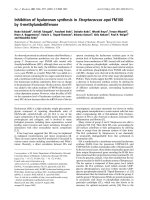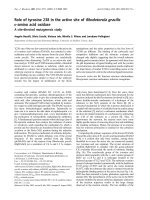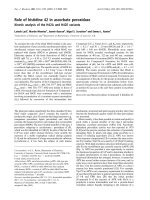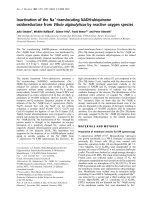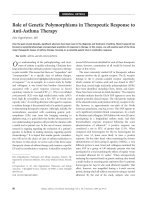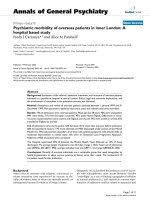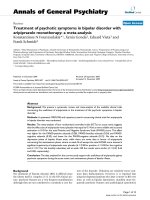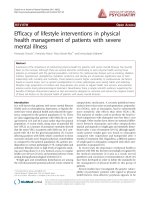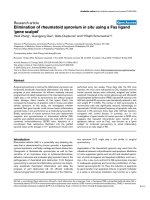Báo cáo y học: "Utilization of outpatient services in refugee settlement health facilities: a comparison by age, gender, and refugee versus host national status" ppt
Bạn đang xem bản rút gọn của tài liệu. Xem và tải ngay bản đầy đủ của tài liệu tại đây (258.17 KB, 15 trang )
RESEARCH Open Access
Utilization of outpatient services in refugee
settlement health facilities: a comparison by age,
gender, and refugee versus host national status
William M Weiss
1*
, Alexander Vu
1,2
, Hannah Tappis
1
, Sarah Meyer
1
, Christopher Haskew
3
and Paul Spiegel
3
Abstract
Background: Comparisons between refugees receiving health care in settlement-based facilities and persons living
in host communities have found that refugees have better health outcomes. However, data that compa res
utilization of health services between refugees and the host population, and across refugee settlements, countries
and regions is limited. The paper will address this information gap. The analysis in this paper uses data from the
United Nations High Commissioner of Refugees (UNHCR) Health Information System (HIS).
Methods: Data about settlement populations and the use of outpatient health services were exported from the
UNHCR health information system database. Tableau Desktop was used to explore the data. STATA was used for
data cleaning and statistical analysis. Differences in various indicators of the use of health services by region,
gender, age groups, and status (host national vs. refugee population) were analyzed for statistical significance using
generalized estimating equation models that adjusted for correlated data within refugee settlements over time.
Results: Eighty-one refugee settlements were included in this study and an average population of 1.53 million
refugees was receiving outpatient health services between 2008 and 2009. The crude utilization rate among
refugees is 2.2 visits per person per year across all settlements. The refugee utilization rate in Asia (3.5) was higher
than in Africa on average (1.8). Among refugees, females have a statistically significant higher utilization rate than
males (2.4 visits per person per year vs. 2.1). The proportion of new outpatient attributable to refugees is higher
than that attributable to host nationals. In the Asian settlements, only 2% outpatient visits, on average, were
attributable to host community members. By contrast, in Africa, the proportion of new outpatient (OPD) visits by
host nationals was 21% on average; in many Ugandan settlements, the proportion of outpatient visits attributable
to host community members was higher than that for refugees. There was no statistically significant difference
between the size of the male and female populations across refugee settlements. Across all settlements reporting
to the UNHCR database, the percent of the refugee population that was less than five years of age is 16% on
average.
Conclusions: The availability of a centralized database of health information across UNHCR-supported refugee
settlements is a rich resource. The SPHERE standard for emergencies of 1-4 visits per person per year appears to be
relevant for Asia in the post-emergency phase, but not for Africa. In Africa, a post-emergency standard of 1-2 visits
per person per year should be considered. Although it is often assumed that the size of the female population in
refugee settlements is higher than males, we found no statistically significant difference between the size of the
male and female populations in refugee settlements overall. Another assumption—that the under-fives make up
20% of the settlement population during the emergency phase—does not appear to hold for the post-emergency
phase; under-fives made up about 16% of refugee settlement populations.
* Correspondence:
1
Department of International Health, Johns Hopkins Bloomberg School of
Public Health, 615 N. Wolfe Street, Baltimore, Maryland, 21205, USA
Full list of author information is available at the end of the article
Weiss et al. Conflict and Health 2011, 5:19
/>© 2011 Weiss et al; licensee BioMed Central Ltd. This is an Open Access article distributed under the terms of the Creative Commons
Attribution License ( whi ch permits unrestricted use, distribution, and reproduction in
any medium, provided the original work is properly cited.
Background
The global estimate number of people who are forcibly
displaced is 43.3 million at the end of 2009. Included in
this population are 15.2 million refugees, of whom 10.4
million fall under mandate of the U nited Nations High
Commissioner of Refugees [1]. Less than half of the
refugees live in settlement facilities. Comparisons
between refugees receiving health care in settlement-
based facilities and persons living in host communities
have found that r efugees have better health o utcomes
[2]. Improved access to health services is attributed to
lower neonatal mortality ra tes and maternal mortal ity
among the refugees when compared to the host popula-
tion in certain settings [3,4]. However, data comparing
utilization of health services between refugees and the
host population, and a cross refugee settlements, coun-
tries a nd regions is limited. The paper will compare the
use of out patient health services by age and gender, and
between refugees and host populations.
TheanalysisinthispaperusesdatafromtheUnited
Nations High Commissioner of Refugees (UNHCR)
Health Information System (HIS). This HIS is a standar-
dized tool used by UNHCR and its partner s to public
health programs delivered to populations of concern [5].
The aim has been to improve the health status of refu-
gees and other displaced persons through evidence-
based policy formulation, better management of health
programs, and ultimately actions that improve refugee
health. In August 2010, a total of 20 operations in
Africa, Asia and Middle East and North Africa regions
were reporting into the HIS using common t ools and
guidelines. The total population under surveillance was
approximately 1.5 million refugees in 102 refugee sites
and across 25 different partners.
Methods
Data about settlement populations and the use of outpa-
tient health services were exported from the UNHCR
health information system database. The data included
settlement specific information about the following:
month of report, total settlement population and popu-
lation size by gender and age group (less than five years
of age, five years of age and older). Outpatient health
services data included the total number of new outpati-
ent visits (for all causes) and a breakdown of this data
by region, country, settlement, month, gender, and sta-
tus (refugee versus host national). We also had data
about outpatient diagnoses and a breakdown by region,
country, settlement, month, age and gender. Information
about use of settlement outpatient services was com-
bined with population data to calculate utilization rates
and proportions where possible. Note that population
denominators were not available for info rmation about
use of settlement outpatient department (OPD) services
by host nationals. Instead, we collected information on
nat ional estimates of the female and less than five years
of age populations [6].
Tableau Desktop was used to explore the data [7].
STATA was used for data cleaning and statistical analy-
sis [8]. Differences in various indicators of the use of
health services by region, gender, age groups, and status
(host national vs. refugee population) were analyzed for
statistical significance using generalized estimating equa-
tion models that adjusted for correlated data within set-
tlements over time.
Results
Table 1 shows the distribution of settlement reports by
region and country. A significant majority of monthly
settlement reports came from the African region. The
number of settlements per country varied widely from
one ( Cameroon, Djibouti, Yemen) to 15 (Chad). In
total, 81 settlements were included in this study and
an average population of 1.53 million refugees was
receiving outpatient health services between 2008 and
2009.
Table 1 Countries represented in the analysis by Region,
Number of Camps Reporting to the UNHCR Health
Information System, and Average Number of Refugees
Served each Month, 2008-09*
Region Host
Country
Number of
Camps
Avg Monthly Population
Served
Asia Bangladesh 2 28,048
Nepal 7 100,525
Thailand 9 198,098
Sub-
Total
18 326,671
Africa Burundi 4 19,546
Cameroon 1 3,871
Chad 15 257,526
Djibouti 1 8,688
Ethiopia 5 72,020
Guinea 1 3,341
Kenya 4 289,861
Rwanda 3 50,365
Sudan 8 98,714
Tanzania 5 198,098
Uganda 11 144,309
Yemen 2 12,115
Zambia 4 49,707
Sub-
Total
65 1,246,118
Total 81 1,534,832
* Countries were exclu ded if camps were pil oting the UNHCR HIS, or where
there were fewer than six monthly reports total for the two-year period for
the country
Weiss et al. Conflict and Health 2011, 5:19
/>Page 2 of 15
Outpatient Utilization Rates for Refugee Populations
The mean number of visits per refugee per year is dis-
played in Table 2. On a monthly basis, refugee settle-
ments report the number of new outpatient visits by
gender. Using these data, along with population data
about females and males, a crude annualized rate of out-
patient utilization was calculated along with rates for
each gender. Because the UNHCR database does not
include information on the size and distribution of the
host populations, it was not possible to calcula te utiliza -
tion rates for the host national population.
Crude OPD utilization rates among refugee populations
The crude utilization rate is 2.2 visits per person per
year across all settlements. The outpatient utilization
rate in Asia (3.5) was higher than in Africa on average
(1.8). In most settlements across countries refugees were
utilizing outpatient services at the SPHERE standard of
1.0 to 4.0 visits per person per year for displaced popu-
lations in emergencies [9]. A few settlements utilization
rates greater than 4.0 (e.g., Bwagiriza settlement in Bur-
undi, Kutupalong settlement in Bangladesh, and Ban
Mae Surin settlement in Thailand). And, some settle-
ments had utilization rates lower than 1.0 (i.e., Yaroun-
gou settlement in Chad, Madi Okollo settlement in
Uganda).
Gender differences in OPD utilization rates among refugee
populations
Across refugee settlements reporting to the UNHCR
database, females have a statistically significant higher
utilization rate than males (2.4 visits per person per year
vs. 2.1). This pattern is seen in all regions. In Africa, uti-
lizations rates for females averaged 2.0 visits per person
per year compared to 1.7 for males. In Asia, female utili-
zation rates averaged 3.8 vs. 3.2 for males. Average utili-
zation rates for both males and females fall within the
SPHERE standard of 1.0 - 4.0 visits per person per year
for emergencies.
Proportion of New Outpatient Visits per Month by Status
and Gender
New OPD visits per month by status
Table 3 shows the mean proportion of new visits in a
month attributable to refugees versus host nationals.
The proportion of new outpatient visits to settlement
health facilities attributable to refugees is higher than
that attributable to host nationals. In the Asian settle-
ments, refugees accounted for about 98% of outpatient
visits. Only 2% outpatient visits, on average, were attri-
butable to host community members. By contrast, in
Africa, the proportion of new outpatient (OPD) visits by
refugees and host nationals was 79% and 21%, respec-
tively. The proportion of outpatient visits attributable to
host community members in Africa varied significantly
from about one percent on average in Djibouti and
Rwanda to as high as 30% or greater in Sudan and
Uganda. In many settlements in Uganda, the proportion
of outpatient visits attributable to host community
membe rs was higher than the propor tion attributable to
refugees. In addition, there is a statistically significant
difference in the proportion of new OPD visits attributa-
ble to host nationals between Asia and Africa (an aver-
age of 18% higher in Africa).
Distribution of gender among refugee populations
Table 4 also shows the proportion of the settlement
population that is female (among ref ugees only). Across
all settlements reporting to the UNHCR database, the
percent of the refugee popul ation that is female was
about the same as the male population; there was no
statistically significant difference between the size of the
male and female populations in refugee settlements
overall. There was some variation , however, within and
between regions. Asian settlements, on average, have a
slightly higher percentage of males than females, except
in Bangladesh. While most of the African settlements
had slightly more female refugees than males, Camer-
oon, Ethiopia, and Kenya have the opposite relationship.
Note that the UNHCR database does not include
information on the size and distribution of the host
populations living near the refugee settlements reporting
to the database. For this reason, we included national
estimates of the size of the female population for host
countries. Asian and African countries included in the
database, on average, have about the same number of
males and females. There are no striking differences
between the percen t of r efugee settlement populations
that are female, and the national estimates of the per-
cent of host country populations that are female.
New OPD Visits per Month by Gender
Table 4 shows mean proportion of new visits in a
month attributable to females. In all but one country
(Chad), the proportion of new OPD visits per month
attributable to female refugees was higher than the
female proportion of the refugee population.
In a majority of African countries, the proportion of
new OPD visits per month attributable to host national
females was higher than national estimates of the female
population in the host country. In Asia, this happened
only in Bangladesh; in the other two Asian countries,
the proportion of new OPD visits per month attributa-
ble to host national females was lower than national
estimates of the female population in the host country.
The proportion of new OPD visits per month attribu-
table to female refugees was also higher than the pro-
portion of new OPD visits attributable to females
among host nationals, with the exception of Yemen and
Thailand.
The proportion of new OPD visits per month attribu-
table to women (among both refugee and host nationals)
Weiss et al. Conflict and Health 2011, 5:19
/>Page 3 of 15
Table 2 Outpatient Department Utilization Rates Per Refugee Per Year by Gender, 2008-2009
All Female Male M v. F p Value*
Region/Country/Camp Rate/Year
*
95% CI* Rate/Year * 95% CI* Rate/Year * 95% CI*
Africa 1.8 1.7, 2.0 2.0 1.8,2.1 1.7 1.5,1.8 < 0.001
Burundi 4.0 3.0, 5.1 4.2 3.1,5.4 3.8 2.8,4.8 < 0.001
Bwagiriza 8.4 6.1,10.7 8.8 6.2,11.4 8.0 6.2,9.8
Gasorwe 2.5 2.3,2.7 2.6 2.3,2.8 2.4 2.1,2.6
Gihinga 4.3 3.7,4.9 4.7 4.1,5.4 3.8 3.2,4.3
Musasa 3.7 3.0,4.4 3.8 3.0,4.6 3.6 3.0,4.2
Cameroon Langui 3.9 3.2,4.5 4.1 3.4,4.8 3.7 3.0,4.3 < 0.05
Chad 1.4 1.2, 1.6 1.6 1.2,2.1 1.4 1.3,1.6
Amboko 1.3 0.9,1.6 1.2 0.8,1.6 1.4 0.8,2.0
Amnabak 0.8 0.6,1.0 0.7 0.6, 0.9 1.0 0.7,1.2
Bredjing 1.3 1.2,1.4 1.2 1.1,1.4 1.3 1.2,1.4
Djabal 1.9 1.7,2.1 1.9 1.7,2.1 2.0 1.8,2.1
Dosseye 2.3 2.0,2.6 2.5 2.2,2.8 2.1 1.8,2.4
Farchana 1.0 0.8,1.2 0.9 0.7,1.1 1.2 1.0,1.5
Gaga 1.1 0.9,1.3 1.1 0.9,1.3 1.1 0.9,1.3
Gondje 0.9 0.6,1.2 0.9 0.6,1.2 0.9 0.6,1.2
Goz Amer 2.0 1.7,2.2 2.0 1.7,2.2 2.0 1.8,2.2
Kounoungou 1.1 0.9,1.2 1.0 0.9,1.2 1.1 1.0,1.3
Mile 1.0 0.9,1.1 1.0 0.9,1.2 1.0 0.9,1.1
Moula 3.5 3.3,3.6 3.7 3.6,3.9 3.2 3.0,3.4
Oure Cassoni 1.3 1.1,1.4 1.2 1.1,1.3 1.3 1.2,1.5
Treguine 1.8 1.6,2.1 4.7 -0.7,10.0 1.9 1.7,2,2
Yaroungou 0.7 0.5,0.8 0.7 0.5,1.0 0.6 0.5,0.7
Djibouti Ali Adde 2.8 2.3, 3.2 3.1 2.6,3.6 2.5 2.1,2.9 < 0.001
Ethiopia 1.7 1.2, 2.1 2.0 1.4,2.5 1.5 1.1,1.9 < 0.001
Awbarre 0.9 0.8,1.1 1.1 0.9,1.3 0.8 0.7,0.9
Fugnido 1.3 1.0,1.5 1.3 1.1,1.6 1.2 0.9,1.5
Kebribeyah 1.7 1.5,1.9 1.9 1.7,2.0 1.6 1.4,1.7
Sherkole 1.9 1.0,2.8 2.1 1.2,3.0 1.7 0.9,2.6
Shimelba 2.7 1.3,4.1 3.6 2.3,4.8 2.3 1.0,3.6
Guinea Kouankan II 3.2 2.3, 4.0 3.4 2.4,4.4 2.9 2.2,3.6 < 0.05
Kenya 1.4 1.3, 1.6 1.5 1.3,1.7 1.4 1.2,1.5 < 0.001
Dagahaley 1.3 1.2,1.4 1.4 1.2,1.5 1.2 1.1,1.4
Hagadera 1.1 1.1,1.2 1.2 1.1,1.3 1.1 1.0,1.1
Ifo 1.3 1.2,1.4 1.4 1.3,1.5 1.3 1.1,1.5
Kakuma 1.9 1.6,2.1 2.0 1.8,2.3 1.8 1.5,2.0
Rwanda 1.7 1.1, 2.4 1.7 1.1,2.3 1.7 1.0,2.4
Gihembe 1.3 1.0,1.6 1.3 1.0,1.6 1.3 1.0,1.6
Kiziba 1.0 0.9,1.2 1.1 1.0,1.2 1.0 0.8,1.1
Nyabiheke 3.0 2.1,4.0 2.9 2.1,3.8 3.2 2.1,4.4
Sudan 2.1 1.6, 2.6 2.4 1.9,2.8 1.8 1.4,2.3 < 0.001
Abuda 2.7 2.3,3.0 3.3 2.8,3.9 3.2 2.1,4.4
Fau 5 4.5 3.5,5.5 4.5 3.6,5.5 4.3 3.3,5.3
Girba 1.7 1.6,1.8 1.9 1.8,2.1 1.4 1.3,1.5
Kilo 26 1.8 1.5,2.0 2.2 1.9,2.5 1.5 1.3,1.6
Shagarab I II III 1.8 1.6,2.0 2.2 1.8,2.6 1.5 1.4,1.6
Suki 2.6 2.3,2.8 3.0 2.7,3.2 2.2 2.0,2.5
Um Gargour 0.9 0.7,1.1 1.2 0.8,1.5 0.8 0.6,1.0
Wad Sharifey 1.3 1.1,1.5 1.3 1.1,1.5 1.2 1.0,1.5
Weiss et al. Conflict and Health 2011, 5:19
/>Page 4 of 15
Table 2 Outpatient Department Utilization Rates Per Refugee Per Year by Gender, 2008-2009 (Continued)
Tanzania 2.6 2.2, 3.0 2.7 2.3,3.2 2.4 2.1,2.7 < 0.001
Lugufu 2.2 1.9,2.5 2.1 1.8,2.5 2.2 1.9,2.6
Lukole 3.3 2.3,4.2 3.7 2.6,4.9 2.9 2.1,3.6
Mtabila 2.8 2.5,3.1 3.1 2.7,3.4 2.5 2.3,2.8
Nduta 3.4 2.3,4.4 3.6 2.5,4.8 3.1 2.1,4.1
Nyarugusu 1.9 1.4,2.4 1.9 1.4,2.5 1.9 1.3,2.4
Uganda 1.2 1.0, 1.4 1.4 1.2,1.6 1.0 0.9,1.2 < 0.001
Adjumani 0.9 0.7,1.0 1.0 0.9,1.1 0.7 0.6,0.8
Ikafe 0.8 0.6,0.9 1.0 0.7,1.3 0.6 0.5,0.7
Imvepi 0.8 0.4,1.1 0.8 0.5,1.0 0.8 0.4,1.2
Kiryandongo 1.5 1.0,2.0 1.7 1.2,2.3 1.3 0.8,1.7
Kyaka II 1.1 0.9,1.3 1.2 1.0,1.4 1.0 0.8,1.2
Kyangwali 1.3 1.2,1.5 1.5 1.3,1.7 1.1 1.0,1.2
Madi Okollo 0.8 0.7,1.0 0.9 0.7,1.1 0.7 0.6,0.9
Nakivale 1.2 0.9,1.5 1.3 1.0,1.6 1.2 0.9,1.6
Oruchinga 2.1 1.3,3.0 2.5 1.6,3.5 1.8 1.0,2.5
Palorinya 1.5 1.1,1.9 1.8 1.5,2.1 1.2 0.7,1.6
Rhino 0.8 0.3,1.3 1.0 0.4,1.6 0.7 0.3,1.1
Yemen Kharaz 2.1 1.3,2.8 2.1 1.3,3.0 2.0 1.4,2.7
Zambia 1.6 1.2, 2.1 1.8 1.3,2.2 1.5 1.1,1.9 < 0.001
Kala 1.0 0.8,1.2 0.9 0.8,1.2 1.0 0.8,1.2
Maheba 2.1 1.0,3.2 2.3 1.1,3.6 1.8 0.9,2.8
Mayukwayukwa 1.2 1.0,1.3 1.4 1.2,1.6 1.0 0.8,1.1
Mwange 2.3 1.9,2.7 2.2 1.8,2.5
Asia 3.5 3.3, 3.7 3.8 3.6,4.0 3.2 3.0,3.4 < 0.001
Bangladesh 4.1 3.2, 4.9 4.2 3.2,5.2 3.9 3.1,4.7 < 0.05
Kutupalong 5.0 4.2,5.7 5.1 4.2,6.1 4.7 4.1,5.4
Nayapara 3.2 2.9,3.4 3.3 3.1,3.6 3.0 2.8,3.3
Nepal 3.5 3.3, 3.8 3.9 3.6,4.1 3.2 2.9,3.4 < 0.001
Beldangi I 3.0 2.5,3.4 3.2 2.8,3.7 2.7 2.3,3.1
Beldangi II 3.1 2.5,3.6 3.4 2.8,4.0 2.8 2.2,3.3
Beldangi II ext 3.4 2.8,3.9 3.7 3.1,4.3 3.0 2.5,3.5
Goldhap 4.4 3.7,5.2 4.9 4.1,5.7 4.0 3.3,4.7
Khudunabari 3.5 3.0,3.9 3.8 3.4,4.2 3.1 2.7,3.6
Sanishare 3.4 3.0,3.8 3.7 3.3,4.1 3.1 2.7,3.5
Timai 4.0 3.4,4.5 4.3 3.7,4.9 3.6 3.1,4.2
Thailand 3.4 3.1, 3.7 3.7 3.3,4.0 3.1 2.9,3.4 < 0.001
Ban Don Yang 3.8 3.5,4.1 4.1 3.7,4.4 3.6 3.3,3.8
Ban Mae Surin 5.3 4.5,6.0 5.8 5.0,6.6 4.8 4.1,5.5
Ban Mai Nai Soi 3.2 2.9,3.5 3.3 3.0,3.5 3.1 2.8,3.4
Mae La 2.4 2.1,2.7 2.4 2.2,2.7 2.3 2.0,2.7
Mae La Oon 3.5 3.3,3.8 3.6 3.3,4.0 3.4 3.1,3.8
Mae Ra Ma Luang 3.9 3.6,4.1 4.2 4.0,4.5 3.5 3.3,3.7
Nu Poh 2.5 2.4,2.6 2.8 2.6,2.9 2.2 2.1,2.3
Tham Hin 3.5 3.2,3.9 3.9 3.5,4.3 3.2 2.9,3.5
Umpiem Mai 2.5 2.3,2.6 2.8 2.6,3.0 2.1 2.0,2.3
All Regions 2.2 2.0,2.4 2.4 2.3,2.6 2.1 1.9,2.2 < 0.001
Asia - Africa Differential 1.7 1.4, 2.0 1.8 1.6,2.1 1.6 1.3,1.8
(p < 0.001) (p < 0.001) (p < 0.001)
* Values, Confidence Intervals and Significance are based on Generalized Estimating Equations, population-averaged model (Std. Err. adjusted for clustering on
Camp)
Weiss et al. Conflict and Health 2011, 5:19
/>Page 5 of 15
Table 3 Mean Proportion of New Outpatient Department Visits per Month by Refugees vs. Host Nationals, 2008-2009
Refugee Host National Ref - Host Difference p Value*
Region/Country/Camp Pct * 95% CI* Pct * 95% CI*
Africa 78.9 73.7,84.2 21.1 15.8,26.3 < .001
Burundi 90.8 87.4,94.2 9.2 5.8,12.6 < .001
Bwagiriza 88.9 78.6,99.1 11.1 0.9,21.4
Gasorwe 91.5 85.2,97.9 8.5 2.1,14.8
Gihinga 93.6 85.1,102.1 6.4 -2.1,14.9
Musasa 89.3 83.9,94.6 10.7 5.4,16.1
Cameroon Langui 96.7 91.1,102.2 3.3 -2.2,8.9 < .001
Chad 88.1 85.9,90.2 11.9 9.8,14.1 < .001
Amboko 98.9 98.1,99.7 1.1 0.3,1.9
Amnabak 85.0 81.7,88.4 15.0 11.6,18.3
Bredjing 95.3 93.5,97.1 4.7 2.9,6.5
Djabal 94.5 90.8,98.1 5.5 1.9,9.2
Dosseye 88.3 86.5,90.1 11.7 9.9,13.5
Farchana 70.2 63.1,77.3 29.8 22.7,36.9
Gaga 87.1 86.4,87.9 12.9 12.1,13.6
Gondje 99.1 98.1,100.2 0.9 -0.2,1.9
Goz Amer 90.3 88.3,92.2 9.7 7.8,11.7
Kounoungou 84.3 82.5,86.1 15.7 13.9,17.5
Mile 84.1 81.5,86.7 15.9 13.3,18.5
Moula 93.3 91.3,95.3 6.7 4.7,8.7
Oure Cassoni 84.4 81.9,86.9 15.6 13.0,18.1
Treguine 84.0 80.5,87.5 16.0 12.5,19.5
Yaroungou 81.6 78.5,84.8 18.4 15.2,21.5
Djibouti Ali Adde 98.8 98.2,99.3 1.2 0.7,1.8 < .001
Ethiopia 85.4 73.7,97.1 14.6 2.9,26.3 < .001
Awbarre 98.3 97.6,99.0 1.7 1.0,2.4
Fugnido 93.8 92.9,94.7 6.2 5.3,7.1
Kebribeyah 91.4 90.1,92.7 8.6 7.3,9.9
Sherkole 63.3 52.9,73.7 36.7 26.3,47.1
Shimelba 72.0 67.8,76.1 28.0 23.9,32.2
Guinea Kouankan II 94.8 91.2,98.5 5.2 1.5,8.8 < .001
Kenya 97.2 91.9,102.5 2.8 -2.5,8.1 < .001
Dagahaley 99.7 99.3,100.1 0.3 -0.1,0.7
Hagadera 99.9 99.9,100.0 0.1 0.0,0.1
Ifo 99.9 99.9,100.0 0.0 0.0,0.1
Kakuma 87.2 86.1,88.4 12.8 11.6,13.9
Rwanda 99.99 99.96,100 0.01 0.0,.03 < .001
Gihembe 99.98 99.9,100 0.0 0.0,0.1
Kiziba 91.1 88.7,93.6 8.9 6.4,11.3
Nyabiheke 100 0
Sudan 64.3 53.5,75.0 35.7 25.0,44.5 < .01
Abuda 56.8 51.8,61.8 43.2 38.2,48.2
Fau 5 38.4 35.1,41.8 61.6 58.2,64.9
Girba 57.8 56.1,59.4 42.2 40.6,43.9
Kilo 26 66.5 62.0,70.9 33.5 29.1,38.0
Shagarab I II III 94.1 91.5,96.6 5.9 3.3,8.5
Suki 36.7 35.4,38.0 63.3 62.0,64.6
Um Gargour 82.9 68.6,97.1 17.1 2.9,31.4
Wad Sharifey 68.6 65.4,71.8 31.4 28.2,34.6
Tanzania 93.3 91.6,95.0 6.7 5.0,8.4 < .001
Weiss et al. Conflict and Health 2011, 5:19
/>Page 6 of 15
Table 3 Mean Proportion of New Outpatient Department Visits per Month by Refugees vs. Host Nationals, 2008 -2009
(Continued)
Lugufu 95.0 94.0,96.1 5.0 3.9,6.0
Lukole 82.9 79.1,86.6 17.1 13.4,20.9
Mtabila 94.9 94.2, 95.6 5.1 4.4,5.8
Nduta 95.7 94.1,97.2 4.3 2.8,5.9
Nyarugusu 92.7 91.7,93.6 7.3 6.4,8.3
Uganda 44.1 33.8,54.4 55.9 45.6,66.2 < .26
Adjumani 29.8 16.1,43.4 70.2 56.6,83.9
Ikafe 12.7 -3.8,29.1 87.4 70.9,103.8
Imvepi 30.7 19.0,42.4 69.3 57.6,81.0
Kiryandongo 56.9 53.2,60.6 43.1 39.4,46.8
Kyaka II 63.5 60.0,67.1 36.5 32.9,40.0
Kyangwali 54.0 48.7,59.3 46.0 40.7,51.3
Madi Okollo 41.6 2.7,80.4 58.4 19.6,97.3
Nakivale 89.7 85.8,93.7 10.3 6.3,14.2
Oruchinga 27.6 19.5,35.7 72.4 64.3,80.5
Palorinya 33.8 15.3,52.4 66.2 47.6,84.7
Rhino 20.8 12.1,29.4 79.2 70.6,87.9
Yemen Kharaz 69.7 65.9,73.5 30.3 26.5,34.1 < .001
Zambia 88.5 82.5,94.5 11.5 5.5,17.5 < .001
Kala 92.0 90.4,93.6 8.0 6.4,9.6
Maheba 76.1 71.3,80.9 23.9 19.1,28.7
Mayukwayukwa 85.5 80.5,90.6 14.5 9.4,19.5
Mwange 98.5 98.0,99.1 1.5 0.9,2.0
Asia 97.6 96.8,98.4 2.4 1.6,3.2 < .001
Bangladesh 97.4 96.0,98.9 2.6 1.1,4.0 < .001
Kutupalong 98.2 95.3,101.1 1.8 -1.1,4.7
Nayapara 96.8 96.0,97.6 3.2 2.4,4.0
Nepal 97.8 96.4,99.2 2.2 0.8,3.6 < .001
Beldangi I 99.4 99.1,99.7 0.6 0.3,0.9
Beldangi II 99.9 99.95,100 0.0 0.0,0.0
Beldangi II ext 99.8 99.7,99.9 0.2 0.1,0.3
Goldhap 97.8 97.5,98.1 2.2 1.9,2.5
Khudunabari 94.5 93.6,95.3 5.5 4.7,6.4
Sanishare 99.9 99.8,99.9 0.1 0.1,0.2
Timai 93.9 93.1,94.7 6.1 5.3,6.9
Thailand 97.5 96.3,98.6 2.5 1.4,3.7 < .001
Ban Don Yang 96.9 95.6,98.1 3.1 1.9,4.4
Ban Mae Surin 99.9 99.9,99.9 0.0 0.0,0.1
Ban Mai Nai Soi 99.9 99.9,100.0 0.0 0.0,0.0
Mae La 96.4 95.9,97.0 3.6 3.0,4.1
Mae La Oon 97.3 96.9,97.8 2.7 2.2,3.1
Mae Ra Ma Luang 98.3 98.0,98.5 1.7 1.5,2.0
Nu Poh 90.2 89.1,91.3 9.8 8.8,10.9
Tham Hin 99.9 99.8,99.9 0.1 0.1,0.2
Umpiem Mai 99.3 99.2,99.5 0.7 0.5,0.8
All Regions 82.9 78.5,87.3 17.1 12.7,21.5 < .001
Asia - Africa Differential (p-value) 18.6 9.2,28.0
(p < .001)
* Values, Confidence Intervals and Significance are based on Generalized Estimating Equations, population-averaged model (Std. Err. adjusted for clustering on
Camp)
Weiss et al. Conflict and Health 2011, 5:19
/>Page 7 of 15
Table 4 Percent of New Outpatient Department Visits by Females, Refugee vs Host Country Patients, 2008-2009
All Refugee Host Pct OPD
Female
Ref - Host
Difference
p Value*
Region/Country/Camp Percent
OPD Visits
Female*
95% CI* Pct.
Refugee
Pop.
Female *
Pct. OPD
Visits
Female*
95% CI* National
Pct Pop
Female
**
Pct. OPD
Visits
Female*
95% CI*
Africa 54.4 53.9,54.9 51.1 54.8 54.4,55.3 50 51.7 50.5,52.8 p < .001
Burundi 54.2 53.0,55.4 51.2 53.9 52.9,55.0 51 53.0 48.9,57.2
Bwagiriza 53.1 51.7,54.5 51.1 53.2 51.9,54.5 42.4 26.0,58.9
Gasorwe 54.9 53.6,56.2 52.2 54.3 53.5,55.1 54.1 46.3,62.0
Gihinga 56.2 54.8,57.5 50.6 56.0 54.8,57.2 56.2 50.8,61.6
Musasa 52.2 49.9,54.4 50.5 51.8 50.0,53.6 53.9 49.6,58.3
Cameroon Langui 51.6 49.6,53.6 48.8 51.7 49.6,53.9 50 45.5 32.9,58.2
Chad 53.9 53.2,54.6 54.9 54.4 53.7,55.1 50 48.4 46.1,50.7 p < .001
Amboko 54.6 51.4,57.8 53.5 54.9 51.6,58.1 35.5 26.5,44.5 p < .001
Amnabak 55.1 54.0,56.2 61.3 55.1 53.9,56.3 54.8 52.3,57.2
Bredjing 51.1 48.8,53.5 54.2 52.5 51.4,53.6 34.3 2,8,65.9
Djabal 52.6 51.5,53.7 54.4 53.0 51.7,54.2 45.7 42.0,49.4 p < .001
Dosseye 57.7 56.8,58.6 54.8 59.2 58.6,59.7 46.3 42.1,50.6 p < .001
Farchana 48.0 45.1,50.8 55.3 49.2 45.9,52.4 45.8 43.7,47.9 p < .05
Gaga 52.7 51.6,53.9 54.4 53.0 51.9,54.1 51.3 49.3,53.4
Gondje 53.2 51.0,55.3 51.6 53.3 51.2,55.4 39.5 26.7,52.3 p < .05
Goz Amer 52.7 51.3,54.1 53.3 53.0 51.6,54.3 49.3 47.8,50.7 p < .001
Kounoungou 55.4 54.4,56.3 56.8 55.1 54.3,55.9 56.6 54.4,58.8
Mile 56.7 55.3,58.2 56.2 57.4 56.1,58.7 52.8 50.7,54.9 p < .001
Moula 53.0 51.3,54.7 49.5 53.4 51.3,55.5 44.8 37.3,52.3
Oure Cassoni 57.7 55.3,60.1 60.2 58.4 55.1,61.6 54.3 51.9,56.7
Treguine 49.3 48.4,50.1 51.3 49.5 48.4,50.5 48.4 46.6,50.2
Yaroungou 54.7 52.6,56.9 53.2 56.0 52.3,59.7 48.1 41.2,55.0
Djibouti Ali Adde 56.2 55.2,57.2 50.8 56.3 55.2,57.4 50 46.4 39.6,53.2 p < .01
Ethiopia 52.6 49.5,55.7 46.2 52.3 48.7,56.0 50 50.3 48.6,51.9
Awbarre 57.7 56.0,59.4 50.9 57.7 56.1,59.4 52.9 47.8,58.0
Fugnido 56.3 55.0,57.7 54.9 56.8 55.4,58.3 49.3 46.4,52.2 p < .001
Kebribeyah 54.8 53.8,55.8 50.4 55.0 54.0,55.9 53.0 50.2,55.8
Sherkole 49.2 45.1,53.2 45.2 48.4 42.9,54.0 49.3 47.8,50.9
Shimelba 42.4 41.7,43.1 28.3 40.8 40.2,41.4 46.9 43.9,50.0 p < .001
Guinea Kouankan
II
56.5 54.2,58.7 53.2 56.7 54.2,59.1 50 54.9 51.6,58.2
Kenya 50.3 49.3,51.2 47.8 50.3 49.3,51.3 50 49.2 40.5,58.0
Dagahaley 51.3 50.5,52.2 49.4 51.3 50.5,52.2 63.3 33.7,93.0
Hagadera 51.7 50.6,52.7 48.7 51.7 50.7,52.7 47.5 32.9,62.1
Ifo 50.9 48.6,53.2 48.9 50.9 48.6,53.2 42.7 18.2,67.2
Kakuma 47.1 46.6,47.7 44.1 47.3 46.5,48.1 46.6 44.7,48.5
Rwanda 56.4 55.0,57.9 55.2 56.4 55.0,57.9 52 ––
Gihembe 56.2 54.8,57.6 54.9 56.2 54.8,57.6 ––
Kiziba 58.3 56.3,60.3 55.0 58.3 56.4,60.2 57.9 54.2,61.6
Nyabiheke 54.3 51.9,56.8 55.9 54.3 51.9,56.8 ––
Sudan 55.6 54.0,57.3 50.0 57.3 56.6,58.0 50 52.4 46.7,58.0
Abuda 58.3 55.1,61.5 48.7 60.5 59.0,62.0 55.7 50.6,60.7 p < .05
Fau 5 52.8 51.3,54.3 54.6 56.5 54.9,58.0 50.8 48.7,52.9 p < .001
Girba 54.6 46.3,62.9 50.2 58.0 57.2,58.8 49.5 29.6,69.4
Weiss et al. Conflict and Health 2011, 5:19
/>Page 8 of 15
Table 4 Percent of New Outpatient Depart ment Visits by Females, Refugee vs Host Country Patients, 2008-2009
(Continued)
Kilo 26 53.7 47.4,59.9 45.2 55.2 54.6,55.8 49.5 30.5,68.5
Shagarab I II III 57.6 53.1,62.2 49.5 58.2 54.8,61.6 56.0 30.6,81.5
Suki 56.3 54.2,58.4 48.5 55.7 53.8,57.7 56.6 53.2,60.1
Um Gargour 54.8 51.6,58.0 47.7 56.6 55.7,57.5 46.8 28.9,64.8
Wad Sharifey 56.8 56.0,57.5 55.9 57.6 57.0,58.2 55.2 53.0,57.4 p < .05
Tanzania 52.8 51.7,53.9 50.7 52.9 51.8,54.0 50 51.2 49.0,53.3 p < .05
Lugufu 49.4 47.5,51.2 51.0 49.3 47.4,51.2 48.9 43.5,54.3
Lukole 55.0 54.2,55.7 49.4 55.8 54.9,56.7 51.0 50.9,51.1 p < .001
Mtabila 55.3 54.8,55.8 50.5 55.3 54.8,55.8 55.5 53.0,58.0
Nduta 54.8 53.6,56.0 50.7 54.8 53.5,56.1 53.4 50.3,56.5
Nyarugusu 51.5 50.5,52.5 51.1 51.8 50.8,52.8 47.2 44.9,49.5 p < .001
Uganda 57.1 56.2,58.0 50.2 57.5 56.5,58.5 50 56.6 55.4,57.7
Adjumani 57.0 55.3,58.7 51.3 58.8 57.2,60.6 55.8 53.3,58.3
Ikafe 55.3 53.2,57.4 46.0 58.3 53.7,62.9 53.6 49.8,57.3
Imvepi 54.4 50.1,58.7 51.2 55.7 48.7,62.6 55.5 52.0,59.1
Kiryandongo 56.7 54.8,58.7 49.8 57.6 55.6,59.6 56.1 53.3,59.0
Kyaka II 56.2 54.1,58.2 50.5 54.5 53.2,55.9 58.0 54.3,61.7
Kyangwali 56.6 54.9,58.3 50.3 58.0 56.8,59.3 55.1 52.6,57.7 p < .001
Madi Okollo 60.9 56.3,65.6 49.6 55.1 50.8,59.4 59.6 52.6,66.7
Nakivale 56.4 54.2,58.7 51.1 56.2 53.8,58.7 56.5 53.8,59.3
Oruchinga 57.7 54.5,60.9 49.7 57.7 56.7,58.7 57.0 52.5,61.6
Palorinya 59.8 56.7,62.9 51.8 61.9 59.6,64.2 58.2 54.2,62.1 p < .01
Rhino 57.1 52.7,61.5 48.0 57.4 54.1,60.8 56.3 50.4,62.1
Yemen Kharaz 53.6 51.5,55.7 50.9 53.3 51.2,55.4 49 53.8 52.0,55.7
Zambia 53.9 52.5,55.3 49.9 54.3 52.9,55.7 50 51.4 49.2,53.6 p < .01
Kala 50.9 49.6,52.2 50.6 51.4 50.1,52.7 47.6 43.4,51.7
Maheba 52.6 50.4,54.8 48.8 53.1 50.7,55.6 49.2 45.5,52.9 p < .05
Mayukwayukwa 57.6 55.5,59.7 49.7 58.2 55.8,60.5 55.1 53.8,56.5 p < .01
Mwange 54.4 53.4,55.4 50.6 54.4 53.3,55.4 53.5 48.3,58.6
Asia 53.3 52.9,53.8 49.4 53.4 52.9,53.9 50 48.5 46.4,50.5 p < .001
Bangladesh 53.3 51.9,54.6 51.5 53.7 52.2,55.1 49 37.4 32.5,42.3 p < .001
Kutupalong 52.8 51.0,54.7 51.2 53.2 51.1,55.2 37.1 28.5,45.7 p < .001
Nayapara 53.7 51.8,55.6 51.9 54.2 52.4,56.1 37.6 32.9,42.4 p < .001
Nepal 54.1 53.7,54.5 49.2 54.2 53.8,54.5 50 50.2 47.0,53.4 p < .05
Beldangi I 54.0 53.2,54.8 49.2 54.0 53.2,54.8 51.8 44.4,59.2
Beldangi II 54.4 52.9,56.0 49.2 54.4 52.9,56.0 59.1 47.3,70.8
Beldangi II ext 54.4 53.5,55.4 49.0 54.4 53.5,55.4 51.3 39.9,62.7
Goldhap 53.9 53.0,54.8 48.8 53.9 53.0,54.9 51.8 49.9,53.8
Khudunabari 54.5 53.5,55.5 49.8 54.6 53.6,55.7 52.2 51.0,53.4 p < .01
Sanishare 54.2 53.6,54.9 49.3 54.2 53.6,54.9 39.6 27.9,51.3 p < .05
Timai 53.2 52.3,54.1 49.0 53.3 52.3,54.2 51.9 50.8,52.9 p < .05
Thailand 52.7 51.9,53.5 49.1 52.7 52.0,53.5 51 50.1 47.5,52.7 p < .05
Ban Don Yang 54.3 53.3,55.2 51.0 54.3 53.3,55.3 55.0 50.2,59.7
Ban Mae Surin 53.3 52.2,54.4 48.4 53.3 52.3,54.4 52.1 12.3,91.8
Ban Mai Nai
Soi
49.5 48.7,50.3 48.2 49.5 48.7,50.3 ––
Mae La 50.5 49.1,51.9 49.3 50.4 49.1,51.8 50.8 48.4,53.2
Mae La Oon 49.6 45.5,53.8 49.1 49.7 45.5,53.9 45.5 41.8,49.3 p < .01
Mae Ra Ma
Luang
54.4 53.2,55.5 49.9 54.5 53.3,55.6 49.2 47.1,51.3 p < .001
Nu Poh 53.7 52.7,54.7 48.2 53.8 52.8,54.8 52.8 51.7,53.9
Tham Hin 53.9 52.9,54.9 48.9 53.9 52.9,54.9 46.7 33.7,59.7
Weiss et al. Conflict and Health 2011, 5:19
/>Page 9 of 15
was higher in African settlements than in Asian settle-
ments. This regio nal difference was greater among host
nationals than among refugees.
Proportion of New Outpatient Diagnoses per Month
Proportion of new outpatient diagnoses by age
Table 5 depicts the mean proportion of new outpatient
diagnosi s each month attributable to children under five
years of age. Table 5 also compares this same propor-
tion between refugee s and host nationals utilizing settle-
ment outpatient services. Because the UNHCR’s Health
Information System database does not document new
visitsbyagegroup,wehaveincludedanalysisofnew
outpatient diagnoses to allow us to look at age patterns
in use of servi ces. By looking at diagnoses, we under-
stand that one person may have multiple diagnoses on a
single visit; there is not a one to one ratio between visits
and diagnoses. The database available only allows for
age-specific analysis for two groups: (1) under five years;
or, (2) five years of age or higher.
Across all settlements reporting to the UNHCR data-
base, the percent of the refugee population that was
less than five years of age is 16% on average (Table 5).
The average unde r-five year population for Asia was
significantly lower than the overall average at 12%. In
general, the Asian population living in refugee settle-
ments was older than the population living African set-
tlements. However, there was considerable variation
among countries. For example, Bangladesh, Tanzania,
Rwanda, Yemen and Zambia had an average under-five
refugee population greater than 19%, while Nepal and
Sudan had rates as low as 8-9%. National estimates of
the size of the under-five population in host countries
are also provided in Table 5 for comparison (this
information is not available at the local level for h ost
populations using refugee settlement health services).
Across all countries contributing to the database, the
estimated und er-five population is an averag e of 14%
(weighted for population size of included countries).
For African countries, the average is 16%; it is 10% for
Asian countries. There is substantial variation between
countries in the estimated proportion less than five
years of age: from 7% in Thailand to over 19% in
Uganda.
Proportion of new outpatient diagnoses attributable to
children less than five years of age by status (refugee vs.
host national)
Although under-fives make up 16% of refugee settle-
ment populations on average, they represent 36% of all
outpatient diagnoses among refugees. Very similar,
although the national estimates of the size of the un der-
five population among host countries averages at 14%,
under-fives represent 36% of outpatient diagnoses
among host nationals.
The proportion of outpatient diagnoses attributable to
under-fives among host nationals was slightly higher
(39%), on average, than the proportion of outpatient
diagnoses attributable to under-fives among refugees
(37%). This pattern was consistent across most African
countries except for Burundi. In Asia, in constrast, the
proportion of outpatient diagnoses attributable to
under-fives among host nationals was much lower (24%)
than the proportion of o utpatient diagnoses attributable
to under-fives among refugees (30%). Overall, the pro-
portion of all new outpatient diagnoses attribut able to
under-fives was lower in Asia (30%) as compared to
Africa (39%).
Discussion
Several studies have compared use of reproductive
health and HIV health services by refugees versus host
communities. However, there is limited information in
the literature about general patterns of use of refugee
health facilities by refugees and members of host com-
munities. The availability of a database, that combines
reports from the majority of refugee settlements sup-
ported by UNHCR and partners, provides a unique
opportuni ty to explore how services differ between gen-
der and age groups, a nd between refugees and host
nationals who utilize the health services of the settle-
ments. The structur e of the database also allows us to
look at overall patterns and to compare and contrast
these patterns between and within regions and
countries.
Utilization rates
Utilization rates among refugees vary between regions.
In Africa, the aver age utilization rate is 1.8. However, in
Table 4 Percent of New Outpatient Depart ment Visits by Females, Refugee vs Host Country Patients, 2008-2009
(Continued)
Umpiem Mai 55.3 54.4,56.2 48.5 55.3 54.5,56.2 49.9 43.3,56.3
All Regions 54.1 53.8,54.5 50.7 54.5 54.1,54.9 50 50.9 49.9,51.9 p < .001
Asia - Africa
Differential (p-value)
-1.1
(p < .05)
-2.0,-0.2 -1.7 (p <
.10)
-1.4 -2.3,-0.6
(p < .01)
0 -3.2 -5.5,-0.9
(p < .01)
* Values, Confidence Intervals and Significance are based on Generalized Estimating Equations, population-averaged model (Std. Err. adjusted for clustering on
Camp); only p-values significant to the .05 level or less are provided.
** Source: World Bank, Health, Nutrition and Population database estimates for 2008 .
Weiss et al. Conflict and Health 2011, 5:19
/>Page 10 of 15
Table 5 Percent of Outpatient Department Diagnoses by Children Less than Five Years of Age (U5), Refugee vs Host
Country Patients, 2008-2009
All Refugee Host Pct OPD
U5
Ref - Host
Difference
p Value*
Region/Country/Camp Percent
OPD
Diagnoses
U5*
95% CI* Pct.
Refugee
Pop.
U5 *
Pct. OPD
Diagnoses
U5*
95% CI* National
Pct. Pop.
U5 **
Pct. OPD
Diagnoses
U5*
95% CI*
Africa 38.6 37.6,39.5 16.9 37.4 36.3,38.5 16.2 39.4 38.2,40.6 p < .001
Burundi 39.8 37.3,42.4 19.4 40.7 38.0,43.4 14.3 28.2 24.3,32.2 p < .001
Bwagiriza 38.3 29.5,47.0 23.4 38.8 30.3,47.2 23.4 7.6,39.3 p < .01
Gasorwe 40.3 39.1,41.6 22.8 41.9 40.5,43.2 23.5 17.7,29.3 p < .001
Gihinga 35.8 33.9,37.7 14.9 36.5 36.5,38.5 27.5 22.9,32.1 p < .01
Musasa 41.9 35.0,48.7 18.6 42.3 35.2,49.5 37.5 32.2,42.7 p < .001
Cameroon Langui 26.6 21.1,32.0 18.5 26.5 21.1,31.9 15.8 29.6 20.2,38.9
Chad 41.7 40.2,43.3 18.4 41.9 40.3,43.6 18.2 39.4 37.1,41.8
Amboko 41.6 31.2,51.9 12.2 41.6 31.2,52.1 28.5 16.7,40.3
Amnabak 36.3 34.1,38.5 23.3 36.0 33.4,38.6 40.6 37.2,44.0
Bredjing 41.4 37.9,44.9 19.0 40.2 37.8,42.7 53.5 37.3,69.7
Djabal 39.6 36.7,42.5 21.2 39.7 36.9,42.4 37.3 29.4,45.3
Dosseye 40.8 37.5,44.1 19.7 38.4 34.8,42.1 53.5 45.1,61.9 p < .01
Farchana 44.1 39.8,48.3 17.2 45.2 41.0,49.5 40.1 36.8,43.4 p < .001
Gaga 44.7 41.3,48.2 20.9 45.8 42.0,49.6 37.7 30.7,44.8 p < .05
Gondje 43.2 30.9,55.4 11.3 43.3 31.1,55.5 26.5 12.2,40.7
Goz Amer 43.7 40.1,47.3 22.2 44.2 39.8,48.5 41.2 37.9,44.6
Kounoungou 40.2 38.7,41.8 17.4 41.2 39.6,42.8 35.8 30.6,41.0
Mile 41.7 38.6,44.8 17.4 43.1 39.0,47.2 35.0 30.2,39.8
Moula 37.5 23.7,51.2 25.0 38.7 24.0,53.4 26.6 22.8,30.3 p < .01
Oure Cassoni 41.7 39.5,43.9 15.6 42.0 39.4,44.5 41.4 35.7,47.1
Treguine 43.2 39.6,46.9 19.1 44.3 40.1,48.6 38.7 33.3,44.1
Yaroungou 43.9 39.6,48.2 18.0 42.2 36.4,48.1 49.6 44.4,54.9 p < .05
Djibouti Ali Adde 34.5 31.0,38.1 16.1 34.5 31.0,38.1 13.5 34.0 16.3,51.7
Ethiopia 41.8 39.9,43.7 17.7 41.4 39.3,43.4 16.5 40.6 35.1,46.0
Awbarre 47.7 44.7,50.7 19.7 48.3 45.2,51.5 41.0 27.4,54.6
Fugnido 40.9 37.7,44.1 23.8 42.1 38.6,45.6 27.2 16.4,38.0 p < .05
Kebribeyah 38.3 36.3,40.3 20.6 37.8 35.7,39.8 43.1 38.1,48.1 p < .05
Sherkole 39.5 36.5,42.6 18.1 38.1 35.5,40.7 42.2 36.2,48.7
Shimelba 43.2 40.0,46.3 9.0 40.7 37.0,44.4 48.9 45.1,52.8 p < .01
Guinea Kouankan
II
28.5 26.5,30.6 14.2 27.8 26.1,29.6 16.7 35.7 21.4,49.9
Kenya 39.5 37.8,41.2 15.4 39.3 37.4,41.1 16.9 39.7 33.5,46.0
Dagahaley 40.6 35.4,45.7 17.2 40.6 35.4,45.7 28.1 15.2,40.9 p < .001
Hagadera 39.0 37.4,40.6 14.9 39.0 37.4,40.5 40.5 19.7,61.3
Ifo 41.7 39.7,43.8 15.4 41.7 39.7,43.8 33.9 16.7,51.1
Kakuma 36.5 33.9,39.1 14.3 35.5 32.6,38.3 43.6 38.8,48.4 p < .01
Rwanda 37.4 34.4,40.5 20.1 37.4 34.4,40.5 17.0 –
Gihembe 32.8 30.7,34.9 17.3 32.8 30.7,34.9 –
Kiziba 38.6 34.2,43.0 21.7 38.6 34.2,43.1 37.8 31.9,43.7
Nyabiheke 41.0 35.2,46.7 21.4 41.0 35.2,46.7 –
Sudan 30.2 27.1,33.3 9.2 27.1 25.2,29.0 14.1 34.9 30.7,39.1 p < .001
Abuda 27.6 22.9,32.3 9.2 25.1 23.0,27.1 33.9 22.9,44.9 p < .05
Fau 5 42.8 40.1,45.4 9.5 34.4 31.3,37.5 47.8 44.0,51.6 p < .001
Weiss et al. Conflict and Health 2011, 5:19
/>Page 11 of 15
Table 5 Percent of Outpatient Department Diagnoses by Children Less than Five Years of Age (U5), Refugee vs Host
Country Patients, 2008-2009 (Continued)
Girba 29.6 27.3,31.9 7.9 27.9 26.0,29.9 33.8 25.7,41.8
Kilo 26 18.9 16.5,21.3 11.1 16.9 14.0,19.8 25.7 15.2,36.1
Shagarab I II III 27.6 25.6,29.7 14.8 27.3 25.4,29.1 29.5 20.7,38.2
Suki 36.8 35.4,38.1 4.5 31.9 28.3,35.4 39.6 35.6,43.5
Um Gargour 29.7 27.1,32.3 11.2 28.1 26.0,30.4 37.6 34.0,41.1 p < .001
Wad Sharifey 30.0 25.3,34.7 5.1 27.7 26.1,29.1 34.1 23.3,44.9
Tanzania 41.8 38.1,45.4 20.3 41.5 37.8,45.2 17.8 44.2 42.1,46.2 p < .05
Lugufu 50.0 47.7,52.2 20.0 50.2 48.0,52.4 46.6 43.2,50.0 p < .05
Lukole 43.8 39.3,48.2 24.9 42.6 37.2,48.0 48.4 47.8,49.0 p < .05
Mtabila 41.5 39.8,43.2 20.0 41.3 39.5,43.0 44.0 42.9,46.9 p < .01
Nduta 32.2 27.0,37.3 20.0 31.8 27.1,36.5 39.7 26.3,53.1
Nyarugusu 39.6 38.3,40.9 19.8 39.3 37.8,40.7 43.4 41.6,45.3 p < .01
Uganda 37.8 36.4,39.2 17.1 33.6 31.9,35.3 19.5 40.8 38.9,42.8 p < .001
Adjumani 41.8 39.9,43.8 14.3 35.2 34.0,36.4 44.7 42.3,47.2 p < .001
Ikafe 45.8 42.8,48.7 13.4 40.3 35.0,45.5 46.6 43.2,49.9 p < .001
Imvepi 34.6 32.2,37.0 10.9 24.1 21.6,26.7 41.0 35.6,46.4 p < .001
Kiryandongo 36.3 34.4,38.3 19.0 34.3 31.2,37.5 38.5 32.7,44.4
Kyaka II 42.6 38.9,46.3 24.8 41.3 37.4,45.3 45.3 39.7,50.8
Kyangwali 38.9 36.2,41.5 19.9 35.6 33.9,37.3 42.8 38.3,47.3 p < .001
Madi Okollo 34.5 31.0,38.0 15.7 30.0 26.5,33.4 37.8 30.7,44.9 p < .001
Nakivale 31.6 27.7,35.6 19.2 31.6 27.4,35.7 35.9 29.0,42.8
Oruchinga 35.1 30.9,39.3 21.5 30.9 26.1,35.7 36.7 30.3,43.2
Palorinya 38.1 34.3,42.0 15.1 38.3 35.2,41.5 38.5 33.0,44.0
Rhino 38.7 32.2,45.2 12.4 27.5 23.8,31.1 42.0 33.1,50.8 p < .001
Yemen Kharaz 40.7 38.1,43.4 19.7 40.4 36.7,44.2 16.3 41.2 39.3,43.2
Zambia 40.6 38.0,43.2 19.7 40.8 38.3,43.3 18.1 38.8 35.0,42.5
Kala 40.9 38.5,43.4 20.0 40.6 38.2,43.0 44.8 41.0,48.5 p < .05
Maheba 39.4 35.6,43.2 19.2 39.7 35.7,43.7 39.4 35.8,43.1
Mayukwayukwa 36.1 34.2,38.0 21.4 36.8 34.4,39.2 30.7 27.6,33.8 p < .01
Mwange 46.9 41.5,52.4 18.0 47.0 41.5,52.5 40.9 31.5,50.3
Asia 30.0 28.9,31.1 12.1 30.1 29.0,31.1 9.8 24.4 21.5,27.2 p < .01
Bangladesh 34.8 32.9,36.7 18.5 35.0 33.2,36.9 10.4 22.8 15.1,30.5 p < .01
Kutupalong 35.4 32.0,38.8 19.0 35.5 32.2,38.9 23.7 15.0,32.4 p < .01
Nayapara 34.1 32.3,35.9 18.2 34.5 32.9,36.2 22.3 8.8,35.7
Nepal 30.9 29.6,32.2 8.0 30.8 29.4,32.1 12.3 27.5 23.5,31.4
Beldangi I 32.3 30.5,34.1 8.6 32.3 30.5,34.1 30.8 23.6,38.0
Beldangi II 28.6 26.3,30.9 7.2 28.6 26.3,30.9 10.0 -3.3,23.4 p < .01
Beldangi II ext 30.1 28.4,31.8 8.1 30.1 28.4,31.8 18.2 8.7,27.7 p < .01
Goldhap 32.6 29.7,35.4 8.1 32.5 29.6,35.4 34.7 29.6,39.8
Khudunabari 26.5 25.5,27.4 6.8 25.7 24.7,26.8 38.7 33.5,44.0 p < .001
Sanishare 36.3 34.7,38.0 8.0 36.4 34.8,38.0 14.3 4.5,24.2 p < .001
Timai 29.3 28.1,30.4 8.7 29.1 27.9,30.3 32.4 26.9,37.8
Thailand 28.2 26.6,29.6 13.5 28.3 26.9,29.8 7.2 18.4 15.4,21.5 p < .001
Ban Don Yang 24.7 23.8,25.7 14.9 25.0 24.0,26.0 18.0 12.3,23.7 p < .01
Ban Mae Surin 26.5 25.5,27.5 13.8 26.5 25.5,27.5 8.3 -6.3,23.0 p < .001
Ban Mai Nai
Soi
39.2 35.9,42.6 12.1 39.2 35.9,42.6 –
Mae La 24.6 23.4,25.8 11.1 24.8 23.6,26.0 16.1 9.0,23.2 p < .001
Mae La Oon 28.7 26.9,30.4 13.2 28.9 27.2,30.7 19.8 10.9,28.7 p < .05
Mae Ra Ma
Luang
26.4 25.3,27.5 15.1 26.6 25.4,27.7 16.2 7.1,25.4 p < .05
Nu Poh 26.0 25.1,26.9 12.0 26.8 25.8,27.8 17.1 10.2,24.1 p < .001
Weiss et al. Conflict and Health 2011, 5:19
/>Page 12 of 15
Asia, it is 3.5 . Both rates are within the range of 1-4 vis-
its per person per year recommended by SPHERE for
the emergency phase. The data in this analysis come
from refugee settlements in the post-emergency phase,
and therefore the SPHERE standard for emergencies
may not be applicable, or may need to vary by region or
context. The current SPHERE standard for emergencies
of 1-4 visits per person per year appears to be relevant
for Asia in the post-emergency phase, but not for Africa.
In Africa, a post-emergency standard of 1-2 visits per
person per year should be considered.
A few settlements had significant over-utilization rates
(> 4 visits per person per year). One question is whether
this increased utilization was due to a specific public
health problem during the 2008-2009, or if it is due to
specific cultural factors or health-seeking behaviors in
certain populations. In contrast, some sett lements had
lower than expected utilization rates. This may suggest
inadequate access to settlement health facilities, low
quality of settlement health services, and/or the avail-
ability of competing health services of higher quality. It
may also reflect acute events that restrict refugee access
to health services in camps for limited periods. For
example, insecurity (e.g. militia attacks in Chad) or nat-
ural disasters (e.g. local flooding in Kenya) or a mix may
be explanations.
Analysis of gender differences in utilization rates
reveals th at female refugees utilize outpatient services at
a higher rate (visits per person per year) than male refu-
gees. This pattern of higher service utilization among
female refugees is consistent across regions and coun-
tries. One possible explanation is that women use out-
patient services for their own routine care, additional
reproductive health needs, and are more likely than men
to accompany children who need services [10].
Distribution of Outpatient Service Users
Overall, the number of refugees using settlement outpa-
tient services is higher than the number of host
nationals using the same services. This pattern is
expected due to the remote/closed nature of refugee set-
tlements in many countries. This means that—although
in principle services are free of charge and accessible to
nationals— ho st populations often prefer to visit host
government sites closer by. UNHCR often also invests
in local health services in refugee hosting areas (e.g.,
referral hospitals) which could help promote local access
to them instead of services inside settlements. Other
possible determinants of health service utilization are
the direct and indirect costs of using the service and
perceived quality of care [11]. However, the latter deter-
minants are context specifi c and thus difficult to gener-
alize for all refugee settlement situations.
In Uganda generally, and in some settlements in
Sudan, however, the opposite trend is observed. In these
special cases, host community members account for
more visits to refugee settlement outpatient services
than refugees. This may reflect the a ttention to inte-
grated services for refugees and host nationals in
Uganda, especially among settlements near the Sudanese
border, that appears in the literature [4,12-14]. In
Uganda, for example, refugee settlements are no longer
refugee camps. Refugees were i ntegrated into existing
villages and health services, some of which already
existed and others which were newly created and are
availab le to all. The Ugandan Ministry of Health is now
a direct implementing partner of UNHCR in some refu-
gee settlements, and UNHCR entirely handed back ser-
vices to local districts. No refug ee-specific services exist
anymore in these places, and therefore it is expected
that refugee and host access will be more equitable.
In eastern Sudan, a number of refugee camps are
located in remote areas more than 15 km from the
nearest national health facility. Therefore, host popula-
tions living near to refugee camps prefer to seek care in
the refugee heal th facilities, as they are much closer by
walking distance ( only 2 - 6 km). Even in areas where
national health facilities are available, refugee health
facilities are often the preferred choice for host commu-
nities as there is a perception that national health ser-
vices cannot meet the needs of host communities due to
inadequate staffing and lack of basic medical supplies.
In addition, high prescription and referral costs in
national services often act as barriers to access to
Table 5 Percent of Outpatient Department Diagnoses by Children Less than Five Years of Age (U5), Refugee vs Host
Country Patients, 2008-2009 (Continued)
Tham Hin 30.5 28.7,32.4 17.1 30.5 28.7,32.4 16.4 3.6,29.2 p < .05
Umpiem Mai 25.9 24.8,27.0 11.3 25.9 24.8,27.0 19.4 5.3,33.6
All Regions 36.5 35.0,37.9 15.7 35.6 34.7,36.6 13.9 36.2 34.8,37.6
Asia - Africa
Differential
-8.6 -11.5,-
5.7
-5.0 -7.3 -9.3,-5.4 -6.4 -15.0 -17.8,-
12.3
p < .001 p < .001 p < .001 p < .001
* Values, Confidence Intervals and Significance are based on Generalized Estimating Equations, population-averaged model (Std. Err. adjusted for clustering on
Camp); only p-values significant to the .05 level or less are provided.
** Source: World Bank, Health, Nutrition and Population database estimates for 2008 .
Weiss et al. Conflict and Health 2011, 5:19
/>Page 13 of 15
government services; whilst in comparison these tend to
be more heavily subsidized within refugee camps.
The proportion of new OPD visits per month attribu-
table to female refugees was higher than the female pro-
portion of the refugee population (in all but one
settlement). Similarly, in most African countries, the
proportion of new OPD visits attributable to host
national females was higher than national estimates of
the proportion of females living in the host country. In
Asia, in contrast, this happened only in Bangladesh. In
Nepal and Thailand, females use refugee-settlement
health services less than would be expected given their
relative size of the population.
Distribution of Diagnoses in Outpatient Services
The proportion of outpatient diagnoses attributable to
refugee children less than five years of age accounts for
over one third (36%) of all refugee outpatient diagnoses,
despite the fact that the under five population makes up
only 16% of the overall refugee population in this study.
Very similar, although the national estimates of the size
of the under-five population among host countries aver-
age at 14%, under-fives also represent 36% of outpatient
diagnoses among host nationals.
It is generally assumed that under-fives make up about
20% of the population in most emergency settings. In
these protracted, post-emergenc y settings, however, it
appears that the under-five population size approximates
that of the host countries. For example, in Africa,
under-fives represented 16-17% of both the refugee
population and the national-level estimate for the host
country. In Asia, under-fives represented 12% of the
refugee population, and 10% of the national estimate of
the host country population. This is probably one expla-
nation for why the proportion of all new outpatient
diagnoses attributable to under-fives was lower in Asia
(30%) as compared to Africa (39%).
The possible influences on the increased utilization
among under-fives proportionate to population size are
multi-factorial, such as the following: a child’snutri-
tional status; the mother’s knowledge and practice of
how to prevent and a ppropriately manage childhood ill-
ness; the social and care environment of the household;
and, increased susceptibility to infectious disease along
with poor access to adequate water supply, sanitation,
and immunizations. These are all potential factors lead-
ing to a larger number of diagnoses among these chil-
dren compared to persons aged five years and above
[15].
Limitations
Because we have no data about the size and dis tribution
of the host populations that are using refugee settlement
health facilities, we cannot assess the rate at which this
population uses these settlement services. We are lim-
ited to observing the following among members of the
host communities: (1) the percent of all visits made to
the outpatient departments of refugee settlement facil-
ities that are made by members of the host national
community; (2) the proportion of these new outpatient
visits by host nationals that are made by females vs.
males; and (3) the proportion of new outpatient diag-
noses by host nationals attributable to under-fives vs.
those five years of age and older. The UNCHCR data-
base disaggregates use of health services by only two age
groups (under fives and five years and above). This lim-
its how much we can identify differences in utilization
by age. There may be variations between settlements in
how utilization numbers and population numbers are
collected and reported to UNHCR, making it difficult to
ensure the validity of comparisons between settlements
and countries. Finally, interpretation of the differences
in specific settlements, countries and regions is some-
what limited by lack of contextual information in the
database to explain these differences.
Conclusions
The availability of a centralized database of health infor-
mation across UNHCR- supported refugee settlements is
arichresourcethatisonlyrecentlybeingutilizedfor
across-settlement analyses. Several conclusions can be
made from this initial analysis. As seen in Uganda, when
refugee health services are integrated into existing host
government services, refugees and locals clearly share
these services more. This is good for equity but more
workneedstobedonetoexaminehowqualityofser-
vices change during and following integration.
The SPHERE standard for emergencies of 1-4 visits
per person per year appears to be relevant for Asia in
the post -emergency phase, but not for A frica. In Africa,
a post-emergency standard of 1-2 visits per person per
year should be considered, w here investigation is indi-
cated if the rate in particular settlement is above or
below that standard. Why some settlements in the data-
base had utilization rates higher or lower than the
expected should be explored.
Although it is often assumed that the size of the
female population in refugee settlements is higher than
males, we found no statistically significant difference
between the size of the male and female populations in
refugee settlements overall. With a few exceptions, Afri-
can settlements tended to have more females, whereas
Asian settlements tended to have more males. The data
do support the idea, however, that females utilize health
services more than males and more than their represen-
tative size of the population.
Another assumption—that the under-fives make up
20% of the settlement population during the emergency
Weiss et al. Conflict and Health 2011, 5:19
/>Page 14 of 15
phase—does not appear to hold for the post-emergency
phase. Under-fives made up 17% of the refugee popula-
tion in Africa, 12% of the population in Asian settle-
ments, and 16% overall. Across both regions, under-fives
use health services at a higher proportion than their
numbers would suggest (37% of OPD visits vs. repre-
senting 16% of the population).
Author details
1
Department of International Health, Johns Hopkins Bloomberg School of
Public Health, 615 N. Wolfe Street, Baltimore, Maryland, 21205, USA.
2
Department of Emergency Medicine, Johns Hopkins School of Medicin e,
Baltimore, Maryland 21205, USA.
3
United Nations High Commissioner for
Refugees, Geneva, Switzerland.
Authors’ contributions
All authors have read and approved the final version of the manuscript. WW
wrote key sections of the Methods, Results, Discussions and Conclusions. He
also designed and carried out exploratory and statistical analysis. AV wrote
key sections of the Background and Discussion and edited the manuscript.
HT and SM compiled the data for analysis, helped write the Background,
and edited the manuscript. CH and PS edited the manuscript and provided
key input into the analysis approach and conclusions.
Competing interests
All authors have received salary support from the UN High Commissioner for
Refugees. This salary support has covered implementation of the Health
Information System described in this paper and/or for writing this
manuscript.
Received: 6 June 2011 Accepted: 21 September 2011
Published: 21 September 2011
References
1. UNHCR: UNHCR 2008 Global Trends: refugees, asylum-seekers, returnees,
internally displaced and stateless persons. June 2009. 2009.
2. CF PSpiegel, Colombo S, Palk E: Health-care needs of people affected by
conflict: future trends and changing frameworks. Lancet 2010,
375(9711):341-345.
3. SM MHynes, Wilson HG, Spiegel P: Reproductive Health Indicators and
Outcomes Among Refugee and Internally Displaced Persons in
Postemergency Phase Camps. Journal of the American Medical Association
2002, 288:595-603.
4. DBV CGOrach: Postemergency health services for refugee and host
populations in Uganda, 1999-2002. Lancet 2004, 364(9434):611-812.
5. Health Information System. [].
6. Health, Nutrition and Population Database. Demographic estimates for
2008. [].
7. Tableau: Tableau Desktop Professional Edition Release 5.0 edition.
Seattle, Wa.: Tableau Software; 2009.
8. StataCorp: Statistical Software: Release 11.0 edition. College Station, TX;
2009.
9. Project S: Sphere Handbook: Humanitarian Charter and Minimum
Standards in Disaster Response. 2004, 268.
10. Rutta E, Williams H, Mwansasu A, Mung’ong’o F, Burke H, Gongo R,
Veneranda R, Qassim M: Refugee perceptions of the quality of healthcare:
findings from a participatory assessment in Ngara, Tanzania. Disasters
2005, 29(4):291-309.
11. Health WCotSDo: Closing the Gap in a Generation: Health Equity through
Action on the Social Determinants of Health. 2008.
12. Rowley EB, Gilbert , Drabe , Rabbin : Protracted Refugee Situations:
Parallel Health Systems and Planning for the Integration of Services.
2006, 2:158-186, 19.
13. Burnham GMR, Elizabeth A, Ovberedjo , Martins O: Quality Design: A
Planning Methodology for the Integration of Refugee and Local Health
Services, West Nile, Uganda. Disasters 2003, 27(1):54-71.
14. Orach CG, De Brouwere V: Integrating refugee and host health services in
West Nile districts, Uganda. Health Policy Plan 2006, 21(1):53-64.
15. Young H, Borrel A, Holland D, Salama P: Public nutrition in complex
emergencies. Lancet 2004, 364(9448):1899-1909.
doi:10.1186/1752-1505-5-19
Cite this article as: Weiss et al.: Utilization of outpatient services in
refugee settlement health facilities: a comparison by age, gender, and
refugee versus host national status. Conflict and Health 2011 5:19.
Submit your next manuscript to BioMed Central
and take full advantage of:
• Convenient online submission
• Thorough peer review
• No space constraints or color figure charges
• Immediate publication on acceptance
• Inclusion in PubMed, CAS, Scopus and Google Scholar
• Research which is freely available for redistribution
Submit your manuscript at
www.biomedcentral.com/submit
Weiss et al. Conflict and Health 2011, 5:19
/>Page 15 of 15
